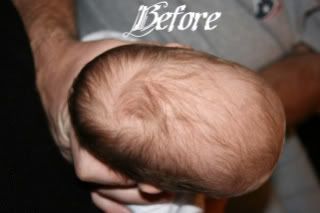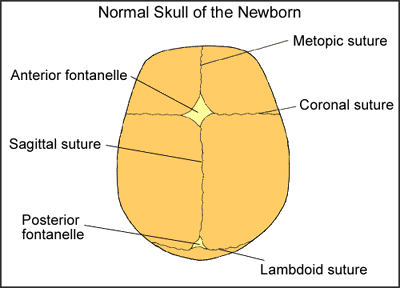Often confused with skull deformation due to birth or sleeping position (positional plagiocephaly), craniosynostosis is a permanent cranial deformation, and the only way to fix it is through surgery. Although there are several theories about the cause of this condition, research has shown that the deformation is sporadic.
When a baby is born, the skull is divided up into different segments, and each segment contains sutures that will ultimately fuse together as a child gets older.
But when a baby is born with craniosynostosis, one or multiple sutures fuse together too early, leaving the brain little or no room to grow. The brain must push its way in a different direction, which most often causes cranial distortion and pain.
If a child waits too long or never receives treatment, the child can be susceptible to physical and developmental problems.
Scaphocephaly (Grayson's type) involves fusion of the sagittal suture. This sutures runs from front to back starting at the fontanel, at the top of the head, and extends backwards along the middle of the skull to the back of the head. Often the fontanel, or soft spot, is absent or closed. A ridge can be seen, or felt, running along the top of the head in between the right and left half of the skull. When viewed from above, the skull is wider near the forehead and gets narrower towards the back of the skull (which is the opposite of what is normal: that is, the back of the skull should be wider than the front). When looking straight on at the child's face, the forehead seems quite big, or prominent, and the sides of the skull look narrow. Often described as resembling a football or a boat.

The incidence of scaphocephaly is one in 2,000 births. It is the most common form of craniosynostosis. Almost all children affected with scaphocephaly require surgical treatment.
Surgery is typically used to separate the fused sutures of the skull as well as to reshape the skull. Typical surgery begins with a zigzag incision from ear to ear across the top of the head. The scar left by this type of incision makes the hair look more natural than that left by a straight incision would.
 Next, a strip of skull is removed along the sagittal suture line. Grayson also had to have a strip of skull removed along the lambdoid suture. So, his strip removal resembled an upside down "Y" shape. He also had some endoscopic cuts made on the side of his skull to "fan" it out so it would widen the back. The skull is then reshaped and held together by dissolvable stitches. Finally, the incision is closed by disolvable stitches and the head is wrapped in dressing and gauze.
Next, a strip of skull is removed along the sagittal suture line. Grayson also had to have a strip of skull removed along the lambdoid suture. So, his strip removal resembled an upside down "Y" shape. He also had some endoscopic cuts made on the side of his skull to "fan" it out so it would widen the back. The skull is then reshaped and held together by dissolvable stitches. Finally, the incision is closed by disolvable stitches and the head is wrapped in dressing and gauze.
2 comments:
hi, Thanks for sharing your story. we are in this process right now with our 4 month old son. His head looks EXACTLY like your son's before photos. Did your son need a helmet or did his skull go back on its own? I have been told we might not need a helmet but other families did. thanks!!
Interesting. I had this done to me when I was a baby 23 years ago. My scar runs straight down the middle of my head though and is about 6inches long. I've never seen it but I am joining the military soon and have to shave my head for boot camp. I didn't really care to research this until recently. Thanks for the information.
Post a Comment